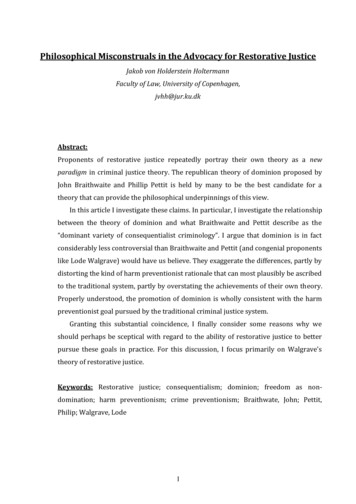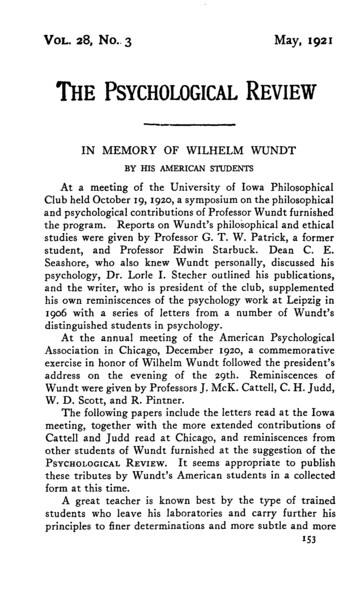
Transcription
Philosophical Misconstruals in the Advocacy for Restorative JusticeJakob von Holderstein HoltermannFaculty of Law, University of Copenhagen,jvhh@jur.ku.dkAbstract:Proponents of restorative justice repeatedly portray their own theory as a newparadigm in criminal justice theory. The republican theory of dominion proposed byJohn Braithwaite and Phillip Pettit is held by many to be the best candidate for atheory that can provide the philosophical underpinnings of this view.In this article I investigate these claims. In particular, I investigate the relationshipbetween the theory of dominion and what Braithwaite and Pettit describe as the“dominant variety of consequentialist criminology”. I argue that dominion is in factconsiderably less controversial than Braithwaite and Pettit (and congenial proponentslike Lode Walgrave) would have us believe. They exaggerate the differences, partly bydistorting the kind of harm preventionist rationale that can most plausibly be ascribedto the traditional system, partly by overstating the achievements of their own theory.Properly understood, the promotion of dominion is wholly consistent with the harmpreventionist goal pursued by the traditional criminal justice system.Granting this substantial coincidence, I finally consider some reasons why weshould perhaps be sceptical with regard to the ability of restorative justice to betterpursue these goals in practice. For this discussion, I focus primarily on Walgrave’stheory of restorative justice.Keywords: Restorative justice; consequentialism; dominion; freedom as nondomination; harm preventionism; crime preventionism; Braithwate, John; Pettit,Philip; Walgrave, Lode1
Any putatively new justice idea – however radical – will contain residual bits of theold.– Kathleen DalyIntroduction:Proponent of restorative justice Lode Walgrave writes in a recent book:“Restorative justice is based on a different paradigm, inspired by a clearly distinctphilosophy It is not possible to judge different paradigms with the same criteria, just asit is not possible to play American football with the rules of soccer.” (Walgrave 2008, p.155)Those familiar with the literature on the subject will know that these words strike a recurrenttheme in the advocacy for restorative justice. 1 But they will also know that the claim to thestatus as new paradigm has been increasingly complicated by the fact that not all criminalcases lend themselves equally well to voluntary processes between stakeholders. Even ifgiven absolute powers to reconstruct the criminal justice system according to restorativewishes, there will inevitably be some cases that are unfit for such processes; cases involving,for instance, openly uncooperative, hardened and dangerous offenders. This, in turn, has ledto a definitional debate between those ‘purist’ proponents who want to reserve the termrestorative justice for voluntary processes (cf. e.g. McCold 2000), and ‘maximalist’ proponentswho aim to create a comprehensive restorative justice system and therefore stand ready toinclude in the definition “non-deliberative schemes, and even judicial sanctions with a view toreparation” (Walgrave 2008, p. 20).2The paradigm claim in relation to restorative justice originates with Zehr (2005 [orig. 1990]). See also, e.g.Johnstone (2002). Other proponents like Braithwaite and Pettit do not use the paradigm claim but neverthelessemphasise the need for something wholly original in replacement of traditional criminal justice: “[I]fconsequentialism is to be vindicated, then we need a very different account of the target which the criminaljustice system ought to promote.” (Braithwaite & Pettit 1990, p. 53)2 Besides Walgrave (e.g. 2002, 2008) the group of maximalists counts also Braithwaite (e.g. 2002a, 2002b),Dignan (2002, 2003) and Van Ness (2002) among others.12
Staying, for present purposes, with the maximalist conception of restorative justice, it isclear that, however limited, any such embrace of judicial sanctions challenges the paradigmclaim. As a result, determining more precisely the general relationship between restorativejustice and traditional criminal justice has occupied a central place in recent debates onrestorative justice. A striking feature of these debates, however, is the virtual absence of whatused to be considered a key player in the field of criminal justice, viz. consequentialistpunishment theories in the tradition descending from Bentham and Hart that justifypunishment primarily because of its ability to realise classical preventionist goals such asdeterrence, incapacitation and rehabilitation.As a rule the general untenability of such preventionist considerations seems simply to beconsidered a matter of course. In the advocacy for restorative justice they are habituallybrushed aside and the rhetorical focus and polemical edge is directed, instead, atretributivism, thus virtually implying that this theory represents the only possible alternative.One striking expression of this tendency is the way proponents of restorative justice tend touse the term retributivism interchangeably to designate not only a particular philosophicaltheory on how best to justify punishment but also the specific, punitively oriented criminaljustice system which the campaign for restorative justice aims to replace. 3 Thus, it is simplydisregarded that these two areas raise questions that are analytically distinct and that other(e.g. consequentialist) philosophical justifications of the criminal justice system are on offer.The tendency to forgo preventionist consequentialism is further illustrated by the factthat when various compromises and hybrid positions have been suggested it has almostexclusively been in the border region between retributivism and restorative justice (cf. e.g.Daly 1999; Duff 2003; Roche 2007; Zedner 1994). To be sure, these suggestions have for themost part been kindly but firmly declined by proponents of restorative justice. In the words ofone prominent proponent: “[T]he marriage of retribution and restorative justice is not awedding we should want to attend.” (Braithwaite 2003b, p. 18) These proponents preferinstead, in accordance with the general empirical predisposition and practical bent of themovement, to stay within a broadly consequentialist outlook in their attempt to dealtheoretically with those cases that resist treatment in voluntary deliberative processes. Butthey do not seem, in any case, to view this as an occasion to revive the old crime preventionistThis is neatly illustrated in the index to Walgrave (2008, p. 236) where the entry on punitive justice simplyredirects to retributivism. Cf. also e.g. Zehr (2005).33
rationales of punishment. Instead, they behave as if a wholly new consequentialistjustificatory framework is needed.In one sense, this general development is perfectly understandable. After all, good oldfashioned consequentialism has fallen on hard times in criminal justice theory during the lastthree to four decades. And it can hardly have taken much persuasion to make modernretributivists assume the role as “last man standing” after the arduous fighting with its oldenemy in the latter half of the twentieth century.4 At the same time, being the new kid on theblock, restorative justice has obviously had an interest in distancing itself from the traditionalconsequentialist positions in the field and in belittling their general significance. Hence, thestrategic importance of the new paradigm claim. Revitalising substantial portions of the oldconsequentialist framework in order to deal with cases that resist treatment in deliberativeprocesses would seriously challenge that claim.Regardless of the understandable motivation, however, I believe that the negligenttreatment of classical preventionism and narrow focus on the relationship betweenretribution and restorative justice is very unfortunate. First, because it often leads to aconfusion of questions of philosophy and practice that are analytically distinct and ought to bekept apart.5 Second, because it makes it too easy for those consequentialist restorativists whorefuse “to attend the marriage of retribution and restorative justice” to get away with theclaim that restorative justice is “inspired by a clearly distinct philosophy” and that it shouldtherefore be judged by wholly different criteria as Walgrave explicitly claims. For thesereasons, my goal in this article is to clarify the relationship between the philosophy ofrestorative justice and classical preventionist consequentialism.Before I proceed, however, this calls for a methodological consideration. As an object oftheoretical reflection restorative justice is anything but simple. As most commentators readilyagree, the term covers a wide variety of theoretical traditions and practices and it is highlydoubtful if any one feature can be singled out that they all share in common. Occasionally, thishas the unfortunate consequence of turning theoretical discussions of restorative justice intoa rather unfruitful game of hide-and-seek where proponents dodge criticism because it fails toaddress “the real” restorative justice whatever that might be. In order to avoid any suchFor an impression of the triumphant mood found in the retributivist camp, see Davis (2009). For a critique, seeHoltermann (2009a).5 Cf. also Daly and Immarigeon: “[A]dvocates unify the punishment goals of just deserts, incapacitation anddeterrence under one heading of the “retributive” model. This is inappropriate and misleading.” (1998, p. 33)44
response I shall focus my discussion primarily on one particular, albeit highly influentialphilosophical argument for restorative justice, i.e. the combined criticism of preventionismand defence of so-called dominion or freedom as non-domination as it is launched byBraithwaite and Pettit in Not Just Deserts : A Republican Theory of Criminal Justice (1990).Braithwaite and Pettit’s discussion has the merit of being both unusually explicit aboutthe reasons for rejecting traditional consequentialist considerations and of addressingdirectly the more fundamental philosophical questions facing restorative justice. In addition,their discussion and general endorsement of dominion as a comprehensive target forrestorative justice has been highly influential, both in their own subsequent writing (cf. e.g.Braithwaite 2002a, 2002b; Braithwaite & Pettit 2000; Pettit & Bratihwaite 1993) and in thewriting of Lode Walgrave (cf. e.g. 2000; 2002, 2005, 2008).6 Thus, this is no doubt “theclearly distinct philosophy” Walgrave has in mind.Hopefully, consequentialist proponents of restorative justice who do not feel touched bythe criticism launched here against Braithwaite and Pettit’s discussion of preventionism anddefence of dominion will be moved to clarify why it should have no bearing on their particularpreferred version of restorative justice.My argument proceeds as follows: In part I, I introduce the criticism of preventionismpresented by Braithwaite and Pettit; in part II, I discuss the so-called insatiability chargelaunched by them and argue that it is a straw man fallacy; in part III, I present the concept ofdominion, and I argue, against Braithwaite and Pettit, that it is wholly consistent withpreventionism; in part IV, I consider and end up rejecting the claim that dominion, unliketraditional consequentialist targets, can never justify punishment of the innocent; and finally,in part V, I argue that, now judging by the same consequentialist criteria, we should besceptical with regard to the ability of restorative justice to outperform traditional criminaljustice.I. Braithwaite and Pettit on preventionismWalgrave repeatedly acknowledges his intellectual debt on the issue of dominion to Braithwaite and Pettit, andhe does not indicate substantial points of disagreement. I shall therefore focus mainly on their account of theconcept. Only in part V shall I return to the specific use of the concept which Walgrave makes.65
In (1990), Braithwaite and Pettit discuss a number of possible overarching goals that couldplausibly be ascribed to the criminal justice system. As a general framework for theirdiscussion, they first “identify three desiderata which every consequentialist theory ofcriminal justice, in particular every consequentialist target, ought to exemplify.” 7 (Braithwaite& Pettit 1990, pp. 41-42) Subsequently they examine the possible candidates vis-à-vis thesedesiderata before they propose their own consequentialist target, i.e. dominion or freedom asnon-domination. The three desiderata are as follows:i)The target should itself be uncontroversial, at least in “Western-style democracies ofthe modern world” (Braithwaite & Pettit 1990, p. 42). This desideratum is more or lesssilent as to how precisely the criminal justice system should be designed. Instead, itfocuses on the fundamental character of the target, and excludes “any candidate whichappeals to a conception of the good – say, a religious view of the point of life – that isradically incapable of commanding consensus in a pluralist society.” (Braithwaite &Pettit 1990, p. 42)ii)The target should furthermore generate an allocation of rights that is: i)uncontroversial; and ii) so-called stable. Uncontroversial rights are such, roughly, asare generally accepted in modern Western rules of law, i.e., for instance, “the right of aparty known to be innocent not to be penalized for a crime, the rights of a personcharged with a crime to a fair trial”. (Braithwaite & Pettit 1990, p. 43) The stabilitycomponent, on the other hand, regards the way these rights are applied to individualcases: “A target would motivate an unstable allocation of rights if it provided a reasonfor establishing the rights in law, but failed to provide a reason why the criminal justiceauthorities, or indeed any other agents, should take the rights seriously.” (Braithwaite& Pettit 1990, p. 43). From the use Braithwaite and Pettit make of the stabilityrequirement it is clear that they take it to imply, in fact, the absolute inviolability of therights question. In considering whether this desideratum is satisfied they focusBraithwaite and Pettit defend the strategy of thus presenting three desiderata as being in accordance with JohnRawls’ idea of evaluating normative theories according to their ability to achieve reflective equilibrium (Rawls1971). I am aware that this strategy can be challenged, but I shall not pursue the question further in the presentcontext – partly because I am fundamentally sympathetic to the general idea of using reflective equilibrium as ayardstick for normative theory. As we shall see, however, I do have some objections to the particular wayBraithwaite and Pettit construe the second and the third desideratum.76
primarily on the ability of satisfying the target while honouring the rights of theinnocent not to be punished.iii)The target should be satiable by which Braithwaite and Pettit mean that the targetshould “motivate respect for uncontroversial limits on the powers associated with thecriminal justice system” (Braithwaite & Pettit 1990, p. 45). For an apt expression ofthis desideratum Braithwaite and Pettit point to the prohibition in the US Constitutionagainst imposing “cruel and unusual punishment”.As far as I can see, there is some redundancy between the second and the third desideratum inBraithwaite and Pettit’s definition that needs to be sorted out. To be sure, the stabilitycomponent of the second desideratum is a distinct part of that desideratum. Stability, as theydescribe it, concerns not the general contents of the rights (i.e. what criminal justice rights dowe have) but their mode of application to individual cases by the agents of the criminal justicesystem (inviolable or not?). But the other dimension of the second desideratum, i.e. theuncontroversiality requirement of the rights motivated by the target, concerns the content ofthese rights. And this aspect of the desideratum is, as far as I can see, also covered by thesatiability desideratum as Braithwaite and Pettit describe it. Criminal justice rights entailcorresponding duties on the part of the authorities (and uncontroversial rights entail, ofcourse, uncontroversial duties). Such duties, however, are essentially a matter of limitsimposed “on the powers associated with the criminal justice system”. And determining thecontroversiality or lack thereof of such limits as would be motivated by a candidate target,was precisely what the satiability desideratum was supposed to do.In other words, it seems as if all criminal justice rights that are uncontroversial will also,eo ipso, constitute “uncontroversial limits on the powers associated with the criminal justicesystem”.8 Perhaps, as Braithwaite and Pettit contend, not all transgression of suchuncontroversial limits will necessarily constitute a transgression of uncontroversial rights.Putting a police officer on every corner, to use their example (1990, p. 44), will probablyThis overlap is also made clear, I believe, by the examples used by Braithwaite and Pettit. Thus, they mention,as one example of insatiability, a system that “prosecutes on the basis of possible rather than probable guilt”(Braithwaite & Pettit 1990, p. 44). But this is arguably the same as not respecting the “right of a party known tobe innocent not to be penalized for a crime [or] the right of a person charged with a crime to a fair trial.” Inaddition, “the limit which prohibits the imposition of ‘cruel and unusual punishment’” (Braithwaite & Pettit1990, p. 45) constitutes what most people would regard as an uncontroversial criminal justice right, i.e. whatBraithwaite and Pettit place under the uncontroversiality dimension of the second desideratum.87
exceed uncontroversial limits but it is unclear if it violates any individual citizens’ rights. Sowe might say that there are two different kinds of limits to the powers of the criminal justicesystem: one that is expressed in the rights of individual citizens and one that constitutes otherduties on behalf of the system to restrain itself. But nothing in Braithwaite and Pettit’sdiscussion turns, as far as I can see, on the ability to express this distinction. And it certainlydoes not make things clearer to have the former kind involved in both criteria as it is inBraithwaite and Pettit’s account.In the following discussion I will therefore exclude the question of the content of criminaljustice rights (i.e. uncontroversial or not) from the second desideratum and reserve thisquestion for the third satiability desideratum. The second desideratum, then, will strictly be amatter of stability in Braithwaite and Pettit’s technical sense, i.e. a matter of the mode ofapplication of the individual criminal justice rights.9 In fact, I believe this way of distinguishingbetween the two desiderata coheres better with the general use Braithwaite and Pettit makeof them in their discussion of various candidate targets for the criminal justice system.I shall focus here only on Braithwaite and Pettit’s discussion and rejection of so-calledpreventionism. Or, to be more precise: Braithwaite and Pettit distinguish between crimepreventionism and harm preventionism, and I shall focus initially only on their discussion ofcrime preventionism and only later (in section III) return to their discussion of harmpreventionism. I do so, partly because Braithwaite and Pettit themselves focus predominantlyon crime preventionism – a choice they justify by crime prevention’s alleged status as “[t]hegoal most frequently ascribed to the criminal justice system” (Braithwaite & Pettit 1990, p.45) and “the dominant variety of consequentialist criminology” (Braithwaite & Pettit 1990, p.46) – and partly because Braithwaite and Pettit’s conception of harm prevention has asomewhat ambivalent relation to their own suggested target for the criminal justice system,i.e. dominion.Braithwaite and Pettit break down the target of crime prevention into its traditional subgoals: incapacitation, rehabilitation and deterrence of potential offenders (Braithwaite &Thus understood the satiability/stability-distinction mimics the distinction proposed by Rawls betweenquestions regarding “a practice of rules to be applied and enforced” (Rawls 1955, p. 5) and questions regarding“the application of particular rules to particular cases.” (Rawls 1955, p. 5) Unlike Rawls, however, Braithwaiteand Pettit insist that the same (consequentialist) rationale must be capable of answering both kinds of questions.98
Pettit 1990, p. 45)10, and they claim that it fails as a plausible target for criminal justice theorybecause it fails to satisfy both the second and third of the above desiderata. It is, as theydramatically put it, “outrageously destabilizing and insatiable.” (1990, p. 45).11 Allegedly,crime preventionism is in such flagrant breach of the second desideratum basically becausepursuing crime prevention can, at least occasionally, lead to punishment of the innocent.12 It isin breach of the third desideratum because it places no limits on the legal means invoked inorder to prevent crimes:“All the preventionist aims are as likely to motivate excessive penalties as they are toencourage intuitively acceptable ones. If there is reason to incapacitate an offender fora limited period, why not incapacitate her so long as she remains a potential nuisance?If there is reason to rehabilitate her, why not keep her under treatment for as long asthe job requires? If there is reason to deter potential offenders by punishing actualones, why not let the punishment increase to an ever more effective deterrent? Boilingoil for bicycle thieves.” (Braithwaite & Pettit 1990, p. 46)The structural problem with the target of crime prevention is simply that it exerts no pullwhatsoever in the direction of moderating the punitiveness of responses to crime: “There isno crime involved in raising the severity of punishment and so crime reduction can press ustowards controversial sorts of punishment.” (Braithwaite & Pettit 1990, p. 47)Thus, because of its alleged breach of the second and third desideratum, Braithwaite andPettit reject that crime prevention can play the important role of a comprehensive goal for thecriminal justice system. A final passage sums up the harsh judgment and makes it crystal clearI believe Braithwaite and Pettit repeat a classical sin of omission in criminological writings on the sub-goalspursued by the criminal justice system. Besides the abovementioned they ought to count among the sub-goals ofcrime prevention also what has been described as “the “displacement function of law”, i.e. the ability ofpunishment to “remove some of the temptation to retaliate” (Gardner 1998, p. 31) This displacement functiongenerally plays little role in most criminological writings. But in political philosophy and history, the state’sability to break off endless vendettas by taking the right and the power to right serious wrongs out of the handsof individuals is traditionally considered a crucial part of its justification. Accidentally, this is precisely thehistorical role assigned to modern rules of law and state punishment that proponents of restorative justice havechallenged most vigorously.11 Analogue passages can be found in other restorative justice writings, cf. e.g. Walgrave (2005, 2008, p. 54).12 A classical exposition of this objection is the fictitious example of the sheriff who only by framing an innocentman can avoid riots that are likely to kill hundreds of people (McCloskey 1957).109
that anything like crime prevention presents a dead end for consequentialist criminal justicetheory:“[I]t is clear that preventionism has absolutely no chance of attaining reflectiveequilibrium. It may invoke a target that looks uncontroversial itself but the target failsto vindicate the uncontroversial rights and limits that are widely recognized in the areaof criminal justice. The target is at open war with our second and third desiderata.”(Braithwaite & Pettit 1990, pp. 46-47)No wonder we need a whole new paradigm.II. Discussion of the insatiability charge – the misconstrual of crime preventionismI believe, however, that this judgment is fundamentally mistaken, and that it rests on a whollymisguided reading of the rationale that can most plausibly be ascribed to proponents of crimeprevention. This reading is most clearly expressed in Braithwaite and Pettit’s argument forthe alleged breach of the third desideratum, and I shall therefore focus initially on this part oftheir argument. Only later (in part IV) shall I return to the second desideratum.To cut a long story short, I believe that Braithwaite and Pettit’s argument with regard tothe third desideratum constitutes a straw man fallacy. Crucial to the argument is the claimthat crime preventionism is wholly one-sided. In their depiction of the crime preventionistrationale, lawful punishment has no independent negative value since, by definition, it doesnot constitute a crime – however “cruel and unusual”. Therefore, no reasons are available tocrime preventionists (as opposed to e.g. harm preventionists, cf. below) to show anymoderation whatsoever in their use of punishment as a crime preventive measure. This isprecisely what is implied by the line of rhetorical questions posed to crime preventionists inthe above quote (p. 9). And this, according to Braithwaite and Pettit, is the central reason whycrime preventionism is in such blatant breach of the satiability desideratum.But this is obviously absurd. In Braithwaite and Pettit’s interpretation, then, crimepreventionists generally believe that crime prevention ought to be pursued relentlessly as theone and only goal for state action; that is, as a kind of “categorical” imperative: Act only in10
such a way as to minimise crime!13 But if indeed anybody did pursue crime prevention in thiscategorical manner we would regularly hear completely different and much more radicalrecommendations than the ones we actually do hear in debates on criminal justice. Not onlywould we have calls for boiling oil for bicycle thieves. We would have calls to end the problemof crime once and for all through, for instance, nuclear eradication of the human species(passed in parliament) or a blanket decriminalisation of all human behaviour. How is that forending crime in a jiffy!Of course, we never do hear such outrageous suggestions not even from the most tallionichardliners, and I believe this should have led Braithwaite and Pettit (along with otherproponents of restorative justice who propagate views to the same effect) to ask whether, inportraying crime preventionists as monomaniacally pursuing a wholly insatiable target, theyhad perhaps failed to interpret their opponents with the kind of charity that could reasonablybe expected in theoretical discussions.14The strategy could have been excused were Braithwaite and Pettit only surveying logicallypossible positions in the theoretical landscape in order, for instance, to articulate more clearlytheir own stance. But they clearly are not. Thus, they write, as earlier mentioned, of crimepreventionism as being “the dominant variety of consequentialist criminology” (Braithwaite &Pettit 1990, p. 46) and refer to what this variety of criminology focuses on “as a matter of fact”(Braithwaite & Pettit 1990, p. 47). Characteristically, however, they do not mention anynames of theorists that have actually proposed such outrageous views, and I must confess thatI rather doubt they can be found. I doubt that we can find, not simply populist politicians whodeserve no place in theoretical discussions but actual thinkers of criminal justice who do notat least occasionally show concern for the cost-side of preventing crime through thepunishment of offenders, e.g. by referring to the importance of simultaneously respecting theban on “cruel and unusual punishment”.Braithwaite and Pettit are not alone in the advocacy for restorative justice in portraying the rationale behindthe traditional criminal justice system in these terms. On the contrary, it is fairly common to find proponents oftraditional criminal justice portrayed as mindlessly pursuing some kind of fetish for unconditional law abidance.For instance, Zehr contrasts restorative justice with something he calls utilitarianism in the following way: “Onepurpose of both punishment and reparation is to send messages. The utilitarian aim of punishment is to say tooffenders, ‘Do not commit offenses because they are against the law.’ ‘Those who do wrong deserve to get hurt.’Reparation or restitution seeks to send a different message. ‘Don’t commit offenses because it harms someone.Those who harm others will have to make it right.’” (Zehr 2005, p. 199)14 A classical and useful definition of the principle of charity is found in Davidson (1980): “[W]e will try for atheory that finds him consistent, a believer of truths, and a lover of the good (all by our own lights it goes withoutsaying).” (p. 222)1311
I would concede that on occasion some preventionists do speak as if their only care in theworld was the prevention of crime. But this fact can hardly support the kind of categoricalreading that leads to the insatiability accusation. On the contrary, such talk can best beinterpreted by reference to the larger context which frames all talk of criminal justice andwhich should therefore tacitly be presupposed.Consider, by way of analogy, a football coach who underlines to her players the immenseimportance of not having goals scored against the team in today’s match. Here we may safelyassume that none of the players will respond to her instructions by defending their own goalwith guns or by building brick walls in front of it. Being competent language users (andfootball players) they will interpret the coach’s instructions as tacitly implying that theyshould avoid having goals scored against them in a ma
Philosophical Misconstruals in the Advocacy for Restorative Justice Jakob von Holderstein Holtermann Faculty of Law, University of Copenhagen, jvhh@jur.ku.dk Abstract: Proponents of restorative justice repeatedly portray their own theory as a new paradigm in criminal justice theory. The republican theory of dominion proposed by










